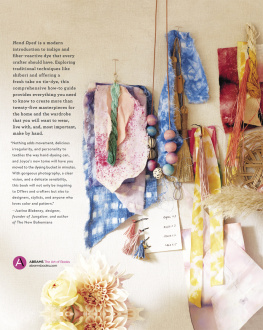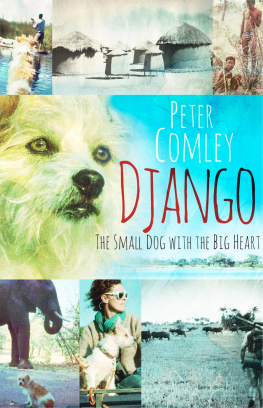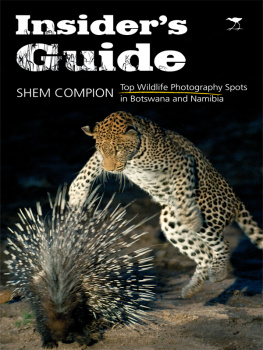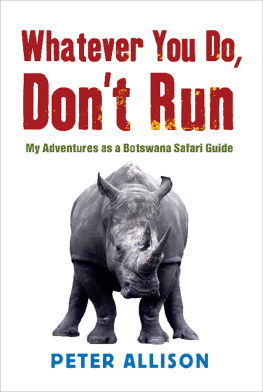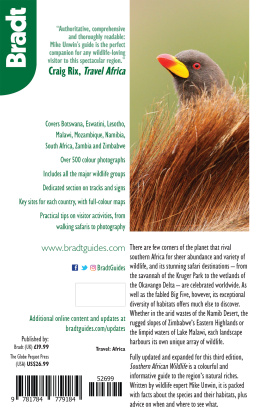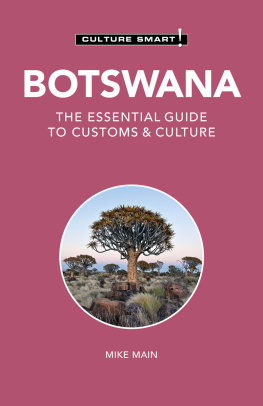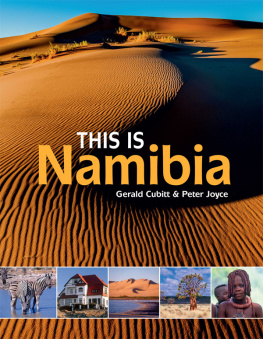
Lions take on a new lease of life with the arrival of the rainy season; soon food will be plentiful.
Published by Struik Travel & Heritage
(an imprint of Penguin Random House (Pty) Ltd)
Company Reg. No. 1953/000441/07
The Estuaries No. 4, Oxbow Crescent,
Century Avenue, Century City, 7441
PO Box 1144, Cape Town 8000, South Africa
Get updates and news by subscribing to our monthly newsletter at www.randomstruik.co.za
First published in hard cover by New Holland Publishers in 1994, 1999 and 2005
Fourth Edition published in softcover by Penguin Random House in 2016
Copyright in published edition: Penguin Random House 1994, 1999, 2005, 2016
Copyright in text: Peter Joyce 1994, 1999, 2005, 2016
Copyright in photographs: Daryl and Sharna Balfour 1994, 1999, 2005, 2016 with the exception of: Tuli lodge (Tuli Safari Lodge Botswana)
IOA = Images of Africa
Publisher: Pippa Parker
Managing editor: Helen de Villiers
Text consultant: Alec Campbell, Botswana National Museum and Art Gallery
Design team: Deirdre Geldenhuys and Gillian Black
Project co-ordinator: Alana Bolligelo
Proofreader: Thea Grobbelaar
ISBN 978 1 92821 338 3 (Print)
ISBN 978 1 92821 339 0 (ePub)
ISBN 978 1 92821 340 6 (PDF)
All rights reserved. No part of this publication may be reproduced, stored in a retrieval system, or transmitted, in any form or by any means, electronic, mechanical, photocopying, recording or otherwise, without the prior written permission of the publishers and copyright holders.
PHOTOGRAPHERS DEDICATION
For David, Cathy, Martin, Tiffany & Ryan Kays our Maun family.
PHOTOGRAPHERS ACKNOWLEDGEMENTS
We would like to thank the numerous people and organizations who assisted us during our travels. We are especially grateful to:
The Government of Botswana including the Office of the President and the Department of Wildlife and National Parks, for making it possible to explore the country and its splendid sanctuaries.
David and Cathy Kays of Ngamiland Adventure Safaris & Rileys Garage, Maun, for opening their home to us and for all their many other courtesies, including the assistance they gave us with this project.
Alan Walkden-Davis of Shell Oil Botswana (Pty) Ltd for the essentials of travel petrol and oil. Botswana is a vast country and we covered more than 15 000 kilometres in three months in our Isuzu four-by-four!
The owners and management of the various camps, lodges and hotels, for their hospitality. Special among them were: Okavango Wilderness Safaris (Mombo and Jedibe); Gametrackers (Xaxaba, Khwai River Lodge and Santawani); Ker & Downey (Pom Pom, Shindi Island and Abus Camp); Lloyd & June Wilmot of Lloyds Camp, Savute; Randall J. Moore and Mike Lorentz for the elephant-back safari; Mashatu Game Lodge; Tuli Game Lodge; Chobe Chilwero; Photo Africa (Linyanti and Selinda); Chobe Game Lodge; Cresta Hotels and Lodges (Mowana Safari Lodge, Chobe, Thapama Lodge, Francistown and The President Hotel, Gaborone); and Jannie & Eileen Drotsky of Drotskys Cabins.
Evelyn & Bing Weskob of Wildlife Helicopter Services. Maun, and to pilot Ray Sharpies for his excellent flying, for help in obtaining the aerial photographs.
Tim Liversedge, the Okavangos Pels fishing owl specialist, for co-operation in photographing these elusive birds.
Last, but certainly not least, to Mom and Philip, who gave us a home from which to operate during our stay in Botswana, and Fred/Dad & Mo/Mom, for all their support over the years, and much, much more.
Daryl and Sharna Balfour
FRONT COVER: Santatadibe River (main pic); black-backed jackal, mokoro trip, African fish eagle, elephant herd, male lion (strip, left to right).
BACK COVER: Herd of zebra (top); black rhino (bottom).

Alert, staring zebras with ears erect, surveying for predators.
CONTENTS

BOTSWANA PROFILE
Probably the most important word in Botswana, a word that holds profound significance for virtually every one of its inhabitants, is pula . It means rain. It is also a form of greeting, an expression of good wishes for the future, and the name for the national unit of currency, but these are secondary applications, definitions that simply emphasize the primacy of and pay tribute to the role of rain in this vast and mostly dry part of south-central Africa.
In Botswana, water is the most precious of all commodities. The great majority of the people depend in one way or another on the land for their wellbeing, and in many instances for their very survival, and the land, all too often, is unforgiving in its arid harshness. The rains are sporadic and unreliable; drought is the norm rather than the exception; huge tracts of territory have no surface moisture, the only permanent sources being the Okavango, the Linyanti-Chobe, and the tributaries of the Shashe and the Limpopo rivers, which bring sustenance to segments of the far northern region but leave the greater part of the country untouched.
These watercourses, however, and especially the first two, combine to make of Botswana one of the African continents finest tourist destinations. The Okavango, born in the uplands of Angola to the north-west, flows into and then spreads over the sandy spaces of the Kalahari to form an immense and wondrous inland delta of lagoon and labyrinthine channel, palm-fringed island and fertile floodplain. Scores of safari lodges and camps have been established in and around this watery wilderness, and in the game-rich Moremi and Chobe reserves farther to the north, and between them they offer visitors the best of several worlds, appealing variously to the game-viewer and birdwatcher, the hunter and the sporting fisherman, the explorer of hidden places and the lover of Africa at its loveliest and least spoilt.
Botswana, which in the old colonial days was known as Bechuanaland, is a big country, scantily populated and landlocked. Its modern name was assumed at independence in 1966 and is derived from the Setswana language, spoken by the largest of the ethnic groupings that in sparse and uneven fashion inhabit a region larger than France and only a little smaller than the American state of Texas. The population is at its densest in the comparatively well-watered south-east, along the common border with South Africas North West and Limpopo provinces. Botswana also shares frontiers with the Northern Cape province in the south, with Zimbabwe in the east and north-east, and with the desert wastelands of Namibia in the west. To the north-west, in striking physical contrast, is Namibias Zambezi Region (formerly Caprivi Strip), a long, narrow and lushly vegetated finger of land distinguished by its rivers and marshlands. A tiny linear segment of this region, stretching just 700 metres from end to end, serves to divide Botswana from the Republic of Zambia the worlds shortest international boundary.

Elephant cows and calves cross the grassy plains of the Savute Marsh, which is fed by an erratic water channel.
THE LAND
Botswana covers 581 730 square kilometres of the Great African Plateau, a gigantic geophysical feature that rises in the Sahara Desert 5 000 kilometres in the north to extend across most of the continent. In Botswana its elevation is at a fairly constant 1 000 metres above sea level, and for the most part the terrain is remarkably uniform, the flat, sun-baked monotony of the countryside unrelieved by hill, ridge or valley a vast, empty land of blistering heat, sand and an infinite silence, of far horizons and, at times, a distinctive and haunting beauty. The main highways are new and in excellent condition, but for the independent traveller intent on exploring the wider spaces movement around the country can be difficult and, in the remoteness of the central and southern regions, even hazardous: distances are enormous, the roads rugged and little used, and if your vehicle breaks down help may be a long time in coming.
Next page






